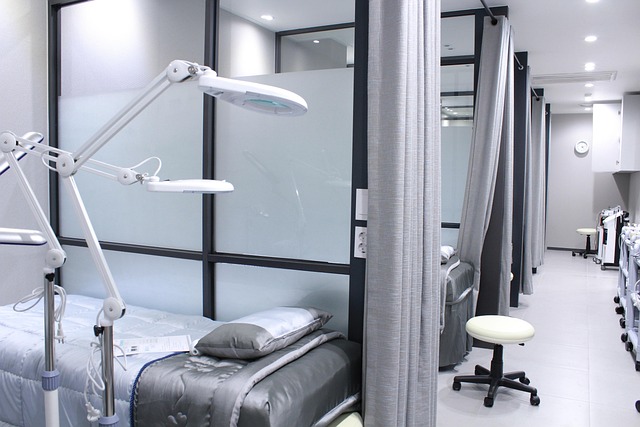Skin tags, caused by friction, genetics, or hormones, can be removed safely by experienced surgeons. While some fall off naturally, others require attention. DIY techniques exist but home removal carries risks. Professional services like cryotherapy or surgical excision offer advanced solutions. Topical creams and natural remedies are initial at-home options guided by experts. Serious symptoms or unusual appearances warrant specialist care from an experienced skin tag removal surgeon. Proper post-removal care is crucial for healing and preventing complications.
Are you tired of dealing with unsightly skin tags at home? Learn the best practices for safe and effective skin tag removal without a trip to the doctor. This comprehensive guide covers understanding skin tags, from causes and types to navigating common mistakes. Discover topical creams, natural remedies, and post-removal care tips. Knowing when to seek an experienced skin tag removal surgeon is also crucial. Master these strategies for clearer, tag-free skin.
- Understanding Skin Tags: Causes and Types
- Safe Removal Methods at Home: A Comprehensive Guide
- Common Mistakes to Avoid During Self-Removal
- Topical Creams and Natural Remedies for Softening Skin Tags
- When to Seek Professional Help from an Experienced Skin Tag Removal Surgeon
- Post-Removal Care Tips for Effective Healing
Understanding Skin Tags: Causes and Types

Skin tags are small, soft skin growths that typically appear as small, hanging pieces of skin. They can develop anywhere on the body but are most commonly found in areas where skin rubs against itself, such as the neck, armpits, and groin. While they are usually harmless, many people choose to remove them for aesthetic reasons or because they find them irritating. Understanding the causes and types of skin tags is essential when considering removal methods.
There are several factors that can contribute to the development of skin tags. The most common cause is friction, as repeated rubbing of skin against itself can lead to the formation of these growths. They can also be linked to genetics, hormonal changes, or obesity. Skin tags can be categorized into different types based on their appearance and location. Common varieties include acrochordons, which are typically found in the armpits or neck, and verrucae, often seen on the hands or feet. An experienced skin tag removal surgeon at a Maidstone skin tag clinic can provide professional skin care services for effective and safe removal, considering both before-and-after results and ensuring optimal patient care.
Safe Removal Methods at Home: A Comprehensive Guide

When considering skin tag removal Wakefiled, it’s crucial to understand that while some tags may fall off on their own, others require attention to prevent discomfort and potential skin irritation. An experienced skin tag removal surgeon can guide you through safe and effective methods, but there are also gentle techniques you can try at home.
For those opting for a DIY approach, the key lies in understanding your skin type and choosing gentle methods of skin tag removal. Products containing salicylic acid or duct tape have shown promise, though results may vary. It’s essential to remember that Gillingham skin tag clinic professionals employ advanced techniques like cryotherapy or surgical excision for more stubborn tags, ensuring quick healing and minimal scarring. Always consult a specialist if tags cause persistent discomfort or are associated with other symptoms.
Common Mistakes to Avoid During Self-Removal

When attempting self-skin tag removal at home, it’s crucial to avoid common pitfalls that can lead to infection, scarring, or discomfort. One major mistake is using sharp objects like pins or scissors to cut off skin tags, which can cause bleeding and leave permanent marks. An experienced skin tag removal surgeon recommends sterile, medical-grade tools for safe procedures.
Another error is ignoring proper hygiene practices. Failing to clean the area thoroughly before and after removal increases the risk of bacterial infections. Moreover, attempting laser skin tag removal at home without professional guidance can be ineffective and potentially harmful. For effective and safe solutions, consider visiting a clinic like Plymouth Skin Tag Clinic or Bolton Skin Tag Removal services for expert advice tailored to your needs.
Topical Creams and Natural Remedies for Softening Skin Tags

Many people opt for topical creams and natural remedies as an initial approach to safely remove skin tags at home, often guided by expert advice on removing skin tags at home. These methods focus on softening and exfoliating the skin tags, making them easier to remove. Over-the-counter creams containing salicylic acid or lactic acid can help soften the skin and shed the dead skin cells, while essential oils like tea tree oil and lavender have anti-inflammatory properties that may reduce the appearance of skin tags.
For those seeking non-surgical skin tag removal near me, Plymouth offers various options. An experienced skin tag removal surgeon can provide professional guidance tailored to your specific needs. They might recommend a combination of topical treatments or, in some cases, minor procedures like cryotherapy (freezing) or lancing to remove the tags effectively while minimising discomfort and potential scarring.
When to Seek Professional Help from an Experienced Skin Tag Removal Surgeon

While many people prefer to remove skin tags at home using over-the-counter remedies or natural treatments, there are instances when seeking professional help from an experienced skin tag removal surgeon is crucial. Despite common beliefs, not all skin tags are harmless and benign; some can be a symptom of underlying medical conditions or skin disorders that require expert attention. If your skin tags are causing discomfort, bleeding, itching, or if they appear unusual in size, shape, or color, it’s time to consider professional removal.
For those located in areas like Canterbury Skin Tag Clinic, Bristol, or Wakefield, accessing private skin tag removal services can be a convenient and effective solution. These specialized clinics offer advanced techniques and expertise tailored to individual needs. Experienced surgeons can diagnose any potential skin concerns, provide personalized treatment options, and ensure safe and precise removal, leaving your skin healthy and free from unwanted tags.
Post-Removal Care Tips for Effective Healing

After successfully removing skin tags at home, proper post-care is essential for optimal healing and to prevent potential complications. One crucial tip is to keep the treated area clean and dry; gently washing with a mild soap and lukewarm water is recommended. Avoid scrubbing or using harsh products, as these can irritate the sensitive skin. Pat the area dry with a soft towel, ensuring no moisture remains, before applying an antiseptic cream or ointment to reduce the risk of infection.
Additionally, experienced skin tag removal surgeons suggest avoiding direct sun exposure for at least 24 hours after the procedure. Using sunscreen with a high SPF is beneficial to protect the healing skin from UV rays. It’s also important not to pick or scratch the area, as this can disrupt the healing process and potentially lead to scarring. If any redness, swelling, or discharge persists beyond a few days, contacting a skin tag clinic, such as those in Woking, Gillingham, or Guildford, for professional advice is advisable.
In conclusion, while home removal methods can be effective, it’s crucial to understand that severe or persistent skin tag issues might require the expertise of an experienced skin tag removal surgeon. Always prioritize safety and consult a professional if you’re unsure. Following these best practices and seeking appropriate care will ensure your skin is treated with the utmost gentleness and respect, leading to smooth, healthy skin.
